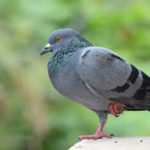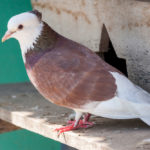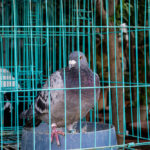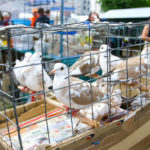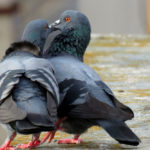A domestic pigeon released into the wild lacks the skills necessary for survival.
These gentle creatures are unable to find food, and can’t protect themselves from dangerous predators. A life outside an aviary isn’t a kindness for them, it’s a cruelty.
Many people are unaware of the disastrous consequences of releasing domesticated pigeons, and assume that all pigeons are equipped to survive in the wild.
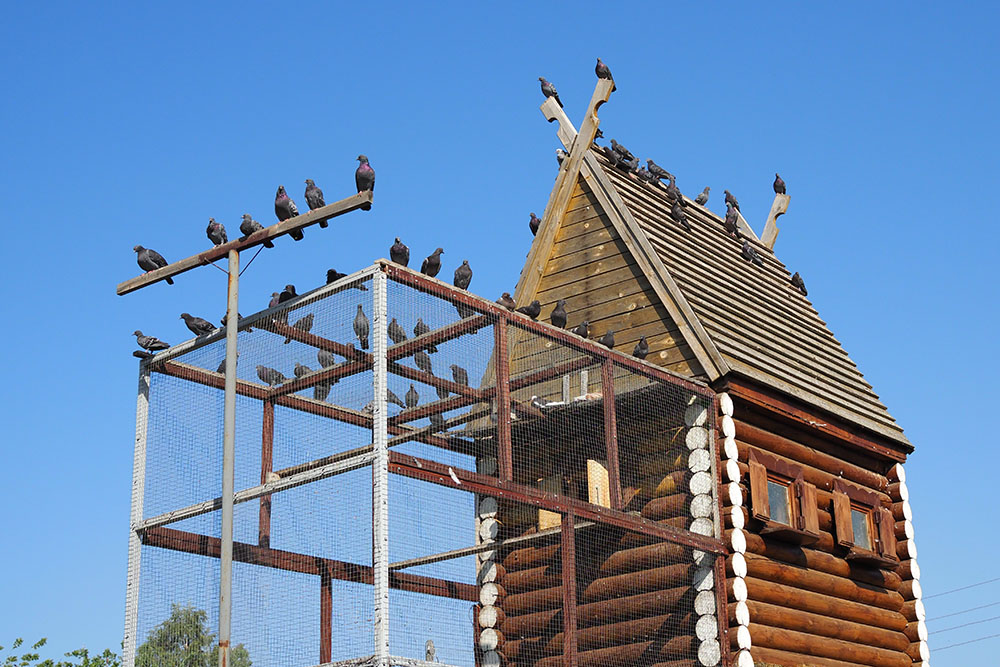
On lucky occasions, these poor pigeons (or doves) can be rescued, and taken to a sanctuary. When this happens, the birds need a new home to live in, and an aviary that can keep them safe.
Building an aviary is easy, and in turn you provide a home for a group of curious and loving pigeons. Looking after rescue pigeons (or doves) is an incredibly rewarding task, as they’re low maintenance pets with big personalities.
With so many domestic pigeons needing rescuing, we hope you have space in your home and heart for an aviary.
Building An Aviary For Rescue Pigeons
What To Know Before You Start Building Your Aviary
Obviously, you can’t just dive right into building an aviary. They may be a fairly simple structure, but there are still some key points that everyone needs to be aware of.
Otherwise, you’ll find yourself needing to do some complex maintenance further down the line (or within days, depending on just how bad your build was).
Before you start building your aviary, here are some things you must know:
- Protection against predators is absolutely essential. A domesticated pigeon struggles to evade predators when set “free”. In an aviary setting, they rely on the home to keep them safe. If a predator gets into the aviary, the results can be disastrous. Ensuring a safe environment should be the first step you take.
- On that note, make sure to consider the predators in your area, and build accordingly.
- Stay away from chicken wire and bird netting. These materials aren’t designed for housing birds, and can cause serious harm.
- Instead of chicken wire, use hardware cloth with mesh openings of .5” or .25”. This cloth must be connected across the entire enclosure, with no gaps. That includes the floor and ceiling.
- Bigger is better when building an aviary for rescue pigeons. But it isn’t the only consideration. Proper shelter, protection from adverse weather, and the right materials for building are also important.
- Pigeons, parrots, and poultry are very different, and have different requirements. Make sure your aviary caters to pigeons!
A well-built aviary can home a domestic pigeon outside year round, no matter how bad the weather gets. Some areas with particularly adverse weather conditions may need to consider other options.
Before starting your build, it’s important to consider how the pigeon will live in the aviary. Decide where the sheltered areas will be, where to provide shade, and how you will feed the pigeon. Don’t forget the cleaning, either. Spending time on the planning will save you from struggling every week with tricky to clean materials.
Finally, make sure the entire structure is predator proof. A secure build is necessary to keep out any larger predators, and use raccoon-proof latches to ensure safety. Think about smaller predators as well. A closer mesh will keep out the rats.
With your aviary built, now you get the joy of caring for your pigeons. Adopting pigeons is a fulfilling task, and the calm and friendly nature of these creatures is hugely rewarding. Make sure to adopt, and never capture a wild bird.
Choosing The Right Size For Your Aviary
The right size for your aviary is basically as big as you can make it. Pigeons will love having the space, and you can get more enjoyment watching them fly free.
By providing plenty of room, you give your rescue pigeons entertainment and exercise. A pigeon with plenty of space will be happy and healthy, compared to a pigeon in cramped conditions.
Choosing the right size for your aviary will also depend on accommodating however many pigeons you have. Pigeons shouldn’t live alone, because they find it stressful.
For 2 to 4 birds, the dimension of the cage should be at least 7 feet long, 4 feet wide, and 6 feet tall. An aviary that’s 8 feet long, 8 feet wide, and 6 feet tall can fit up to 10 pigeons.
If you do have a single pigeon, they can be kept in a smaller cage, but that cage should be indoors. The pigeon then has you for company, and a house to fly around in.
As well as accommodating the pigeons, an aviary should have room for a person. This allows the owner to enter the aviary for feeding and cleaning. If possible, build with enough space for seating a person. That way, you’re able to fully enjoy time with your birds.
Aviaries are a lovely place to spend a day, so don’t worry about how much room it might take up in a yard. A seating area or patio can be converted into an aviary, while still providing a place to sit.
Deciding On Dimensions And Design
One of the first decisions when building your aviary is the shape. We recommend a rectangular aviary.
This shape is the easiest to build, and easier to expand. Circular aviaries may look great, but it’s very difficult to build them with wide enough dimensions. It’s hard to build a circular aviary with enough space for pigeons to stretch their wings.
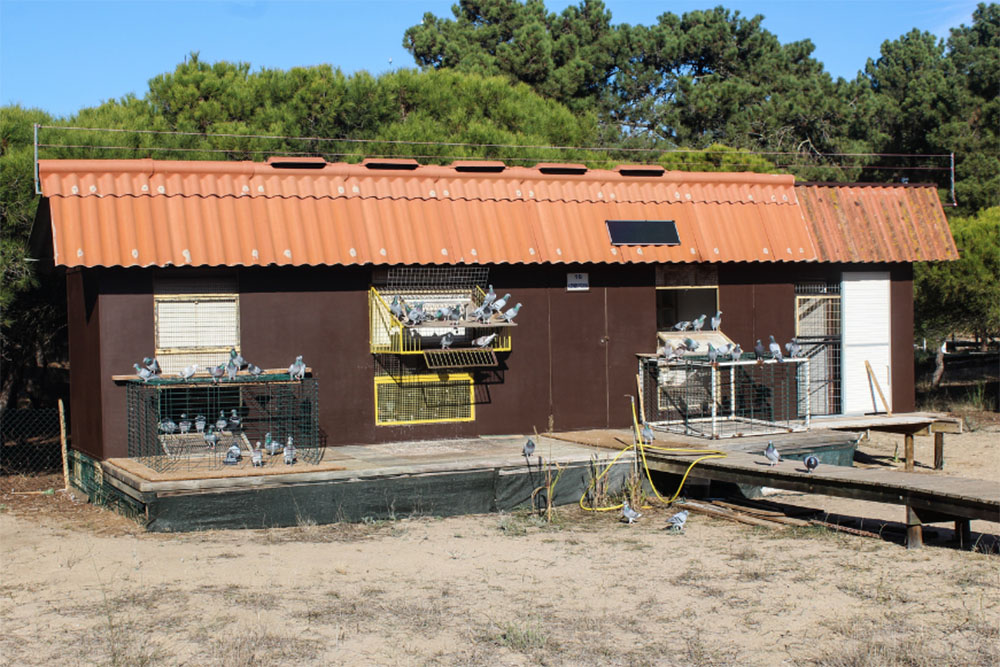
Pigeons will use the full length of the aviary. They feed from the ground, and despite being able to fly, a pigeon enjoys spending time walking and preening. A good width, at least 4 feet for two birds, gives them space to move about on the ground.
A domesticated pigeon can’t live in the wild, but even injured birds need the opportunity to flap their wings.
An aviary must be at least 7 feet wide, so the birds can properly move their wings. Smaller than that, and they won’t have the space they need to move.
Pigeons might not perch in the way parrots do, but they still like to spend time higher up. A taller aviary not only provides the pigeons with room to fly, but it also allows you to add perches for the pigeons to sit on.
The full height, width, and length of the cage will be used by the pigeons, so you can see why bigger is best.
The final area of design to consider is the roof. Slightly sloping roofs are easier to clean (and less likely to become damaged in heavy rainfall). Don’t cover all the mesh on the roof. Roughly half should be exposed, to allow the weather in, and let the air out.
Finding A Location For Your Aviary
Depending on the size of your yard and the size of your aviary, you may be limited on where exactly to put the thing. Still, you don’t want to just place it anywhere. The right location will enhance the experience for both you, and your birds.
Pigeons love to be in the sunshine, so choose an area that’s bright for several hours a day.
Domestic pigeons actually appreciate a lot of weather conditions, and won’t be put off by a bit of rain. The best place for an aviary is out in the open, where the pigeons can feel the outdoors, without the risk.
If you’re worrying about the weather, we’ll discuss shelter later. The important thing to know is that shelter is built into the aviary, and doesn’t need to come from an outside source.
Another location factor that’s essential is how well you can see the aviary. Pigeons are so fun to watch and spend time with. Place your aviary somewhere it can be enjoyed.
Expect your pigeon to coo, but they aren’t particularly noisy birds. However, keep in mind that persistent cooing from several birds might bother the neighbors.
Materials For The Foundation
Once you know your design, and you’ve decided on a location, it’s time to start constructing your aviary.
The foundation can be a tricky area to get right, because it needs to be comfortable for the pigeons, protected against predators, and easy to maintain.
Once the foundation is in, making changes is often more complex than other adjustments. So, make sure to give this section lots of thought.
Cement pads are common choices for aviary foundations, because many aviaries are converted patios. A cement floor can be easy to clean (although it will require regular scraping). Protection against predators is the biggest advantage of a cement pad.
With cement, no hardware cloth is needed. The main issue with cement is drainage. Consider either a sloping floor, or installing a drainage system.
If using cement paving slabs, tile, vinyl, or hardwood, a layer of hardware mesh must be used underneath.
This protects against predators who might chew or scratch through the foundation. The mesh should be connected all the way around, and form a tight seal with the sides of the aviary.
Pigeons can’t walk directly on hardware cloth. The open mesh is painful on pigeon feet, and it can cause them stress.
When building an aviary directly onto earth, use a layer of hardware mesh, covered in either tiles, or slabs. Smooth surfaces are easier for owners, because they can be scraped clean. And always consider the drainage as part of the initial design.
Starting Your Build
With the foundation in place, the real building work can start. Which brings us to one of the most important considerations for the aviary: the mesh.
The hardware cloth that’s used to form the walls of the aviary has a dual purpose.
It needs to be a safe material that keeps the pigeons in, without causing them harm. It also must be sturdy enough to withstand clawing and gnawing from predators who may try to injure your lovely pigeons.
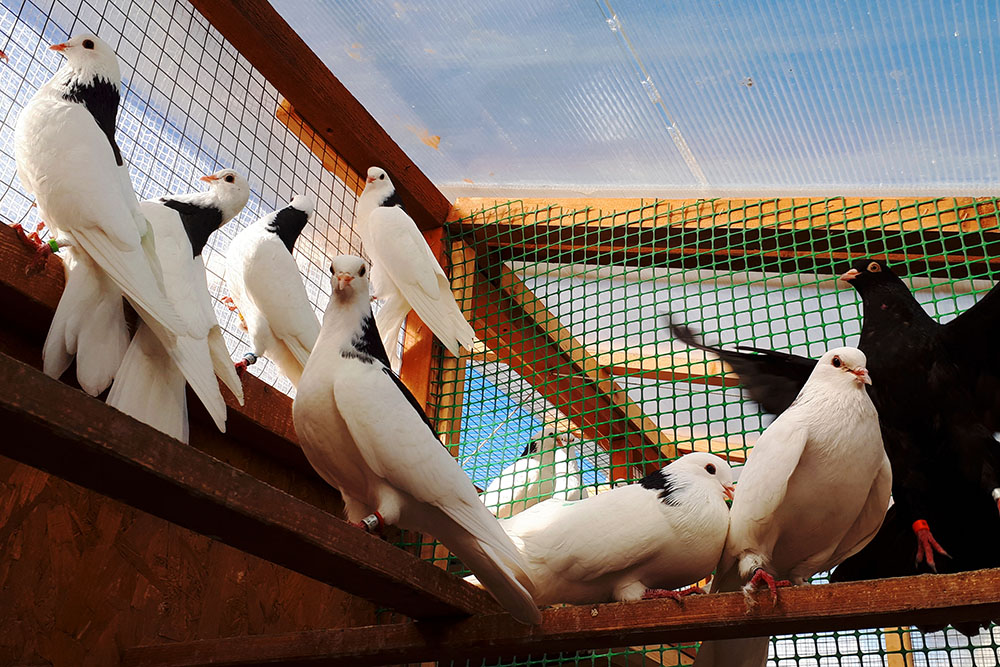
If you’ve ever seen a raccoon after your trash, you’ll understand that they’re persistent creatures. Any slight areas of weakness can fall victim to their surprisingly strong and clever fingers.
Rats are another big problem. Sneaky, and with very sharp teeth, the mesh needs to protect the pigeons from rats coming at all angles. This is part of the reason why that base layer is of vital importance.
Neighborhood cats also need to be protected against. With long limbs and an almost ruthless determination, cats can reach into improperly protected aviaries, and swipe your pigeon in their home.
So, when deciding on the mesh for your aviary, you need to consider the strength of the material, and the size of the openings.
Mesh for an aviary should have an opening of .25”, or .5”. Any larger than that, and you risk letting in the paws of predators. Mesh that’s above .5” can also let in small mice. Although mice may not pose an active risk to the pigeons, they can still cause a lot of bother.
Having selected a strong and sturdy mesh, it needs to be connected all the way around the aviary. Using panels is often the easiest way to construct an aviary, but be sure that the mesh is firmly secured. Mesh needs to cover the sides, base, and roof of the aviary.
Finally, use raccoon-proof locks and latches. Raccoons can easily lift regular latches, and let themselves in.
Does An Aviary Need A Sheltered Area?
Pigeons like all kinds of weather — they’re very hardy birds. But even the most adventurous of pigeons need some shelter in their aviary.
The first reason for shelter in an aviary is to provide protection against the sun. On very hot days, direct sunlight can be dangerous for pigeons. A sheltered area will keep cool, so your pigeons can retreat to the shade as the day heats up.
Second, you need protection against the heavy winter rains. These are the cold and powerful rains that drive into you.
Even though pigeons are generally pretty happy in a rain shower, heavy rains can become uncomfortable and stressful. Some shelter will protect your pigeon from the worst of it.
Finally, you might be surprised to learn that pigeons can be quite happy in the snow. Adding shelter simply keeps the warmth in, so your pigeons don’t get too cold. If you live somewhere with very persistent snow, consider heavier shelter, or keep your pigeons indoors.
Keeping your pigeons sheltered from adverse weather conditions is an important reason to build cover on your aviary. But there’s one reason that tops all of them: keeping the nest boxes dry. A dry nest box is easier to clean, and it helps prevent parasites from thriving.
A half-and-half approach is the best configuration for aviary shelter. Half the aviary should be sheltered, and half the aviary mesh should be uncovered.
What About Nest Boxes?
Pigeons need nest boxes for comfort, even if they don’t need them for breeding — and we don’t recommend breeding your pigeons. Rescuing pigeons is important because so many of them go without care.
When you want to add more pigeons to your aviary, adopt, don’t breed.
A nest box provides a pigeon with a safe place to get cozy, and you need to have some in your aviary. Nest boxes can be quite simple, and often bought ready-made.
Prefer a hands-on approach? Building a nest box is easy, because they only need to be a wooden box with an opening. Make sure to smooth down any rough edges, so the pigeons can’t hurt themselves.
For a pair of pigeons, a nest box should be 12” long, 12” deep, and 12” tall. Nest boxes for chickens tend to be the right size. Elaborate nest boxes include perches, privacy shields, and landing strips.
Space the nesting boxes out around the aviary, keeping them all under shelter. Pigeons can get protective over their nesting box, and a bit of space reduces tensions. Placing the nest boxes vertically also helps to prevent arguments.
Pigeons pick someone to mate with once they mature at around 5 months old. These pigeons will nest together, within the box, often resulting in the hen laying eggs. Once real eggs have been laid, replace them with fake eggs, and destroy the originals.
Branches And Entertainment
Perches and branches provide good entertainment for both you, and your pigeon. Having a place for your pigeon to perch near the mesh front of the aviary allows the pigeon to watch all the comings and goings, and you can watch your pigeon in return.
Perches also help ensure your pigeon is getting enough exercise. They’ll be able to leap and fly to and from the perches, and explore all the space in the aviary.
Natural branches are actually some of the best materials to use when creating a pigeon perch. The variety of thicknesses helps to exercise the pigeon claws, as they need to grip with varying degrees of strength.
Otherwise, use pre-bought perches of different thickness. It will provide the pigeons with that little extra stimulation.
As the aviary has a decent amount of height (at least 6 foot), perches can provide a variety of seating areas. Give them somewhere to perch in both the middle and upper reaches, so they can really explore.
Something else that will keep your pigeon entertained is a mirror. This will also be very entertaining for you to watch, as they sort of understand their reflection, and have been shown to recognize themselves.
Pigeons won’t fight with a mirror. Instead, you might get to see them preen.
Pigeons are intelligent birds, and are interested in the world around them. They won’t get frightened by the things happening in the yard, so feel free to move about as you would. In fact, your pigeon may enjoy watching what you get up to.
Feeding
With the rest of your aviary set up, the final thing to add are areas for eating and drinking. For pigeons, feeding spaces and drinking bowls only need to be simple.
It’s important to provide your pigeons with fresh, clean water, every day. Pigeons aren’t fussy about what they drink from. As long as the container is around 2-4 inches deep, and kept clean, your pigeons will be happy.
Anything from Tupperware dishes to roasting tins will work. Use a clear container if you can. The pigeons won’t care either way, but you get to watch them drink properly.
It’s helpful to have more than one water dish, because it means you can give it a proper clean regularly. Washing the dish every day might not be a necessity, but it is a good habit to get into.
For food, a dinner plate is good enough for the pigeons. Sturdier bird feeders can also be purchased, but make sure that they can be placed flat on the ground. Feeders for chickens often work quite well.
Food and water dishes should be made out of non-toxic materials, and kept clean.
A cup full of pigeon feed is good for four birds, and should be provided daily. These mixtures contain everything a pigeon needs for a healthy diet. Leafy greens such as spinach are nice for an occasional treat.
Pigeons eat food from the ground, so place both the dishes on the floor. Pigeons can also be trained to eat from the hand, although this is only done as a fun bonding experience. Hand feeding your pigeons every day is going to take a while.
Keeping Your Aviary Clean
An aviary requires some care to keep it clean — anyone who owns pigeons will be more than aware of how much they poop.
How often the aviary needs to be cleaned will depend largely on how many pigeons you care for, and what material is used on the floor. A smooth surface is easiest to clean. Use a paint scraper to remove the poop.
Having the right amount of pigeons for the space will lessen the need for daily cleaning. Aviaries that are crowded with pigeons need higher care — just one of the many reasons to build an aviary the right size.
Food and water must be replaced daily. Wash out the dishes regularly.
Once a week, rinse the aviary with a hose. This prevents the need for a very thorough cleaning. Make sure the nest boxes are clean and dry as well. You can do this as you check for eggs.
Don’t forget about the roof, either. Although it won’t need cleaning, any debris or water puddles should be dealt with. Otherwise, you risk the roof breaking.
How Often Is Maintenance Needed?
Now you’re ready to move your pigeons in! Their lovely new aviary should provide a stable and secure home for years to come.
With any luck, it will be awhile before you need to do any real work to keep the aviary in top condition. A regular cleaning schedule gives you an opportunity to check the aviary for weak spots or breakages.
When you get your first pigeons in, watch them closely to see how well they adapt to their new home. This shouldn’t be a struggle. As these gentle creatures start to explore the space, you won’t want to take your eyes off them.
It can always be a tense moment during the first rainstorm, or when heavy winds pass by. Give the aviary an inspection to make sure that it held up, and make any improvements that may be necessary.
Two of the biggest challenges in maintaining an aviary are keeping the foundation drained, and protecting against predators. By considering all your options thoroughly, and ensuring a strong build, there should be minimal problems down the line.
If a raccoon or cat can’t identify any weak spots, then they’re likely to leave your pigeons alone. With the right materials for the foundation, and the occasional brush with a broom, draining shouldn’t cause an issue.
Anything Else?
A rescue pigeon has had to deal with a lot of stress before they get a chance to move into their new home. That’s just one of the reasons why we must do what we can to ensure the aviaries are as nice a place to live as possible.
If you’re worried about fitting an aviary into your yard, get creative. Aviaries are so fun to sit in and spend time in, that they can only enhance a space. Consider how to add an aviary to a seating area, and how to incorporate a design into the existing features of the yard.
Once you have your pigeons, you’ll wonder how you ever lived without them. These low maintenance birds are gentle and kind, and so fun to watch as they move about their homes. Spend enough time with them, and you’ll soon feel a part of the flock.
The key features of an aviary are space and safety. Once you have these sorted, the rest of the build is easy. Then all you need to do is rescue some pigeons!

